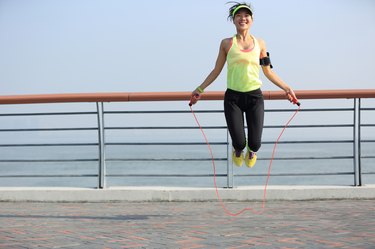
Jumping rope provides an intense full-body workout, effectively improving cardiovascular fitness. It's also high impact, increasing the chances of getting shin splints. There are many surfaces on which you can jump rope, including concrete, mats, grass and sand. While it's up to you to decide which one is best for your needs, most of the surfaces have advantages and disadvantages.
Concrete
Video of the Day
Concrete is the most commonly used surface for jumping rope. It is solid which allows you to easily push off from while its rough texture provides excellent grip and prevents slipping. You can jump the fastest on concrete because it allows for the best rebound. However, concrete is very dense and does not provide any shock absorption upon landing, increasing your chance of getting shin splints. Asphalt is slightly softer than concrete, but is still hard on your joints.
Video of the Day
Mats
Athletes, such as boxers, typically jump rope on mats. Mats provide excellent cushioning and absorb the majority of the impact upon landing. Since they're not firm like concrete, mats also require more force to push off, providing a more effective workout for your calves. On the downside, this requirement for increased force will not allow for as fast of a jumping pace, which will decrease the cardiovascular benefits.
Grass
Jumping rope on grass can provide many benefits. The lack of support and somewhat slick surface will work unused muscles in the shins and feet. Grass also provides considerable shock absorption upon landing. On the other hand, in the morning and after it rains, the surface will be slippery, increasing the risk for injury.
Sand
Sand is an effective surface for jumping rope. First, it is soft and conforms to your landing, reducing impact force. Second, it requires a considerable amount of force to push off from, but compacts upon landing, allowing you to jump at a fast pace. Third, its unstable nature incorporates muscles in the shins and feet. Lastly, it is soft and will not inflict injury upon landing or falling, making it an ideal surface for jumping rope.